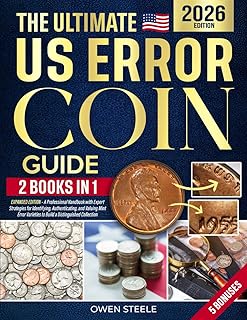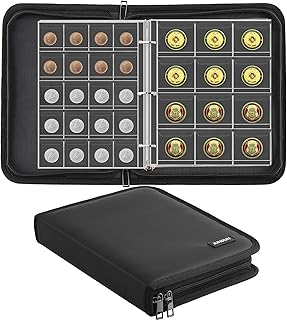Coin collecting is a fascinating and rewarding hobby that has captured the interest of many for centuries. It bridges the gap between history and investment, art and economics. Despite a common misconception that the pursuit is exclusively for the wealthy, coin collecting is a hobby that can suit any budget. The trick lies in understanding how to begin, progress, and perhaps most importantly, how to harness the joy and education the hobby affords without undue strain on your finances.
Coin collecting is a fascinating and rewarding hobby that has captured the interest of many for centuries. It bridges the gap between history and investment, art and economics. Despite a common misconception that the pursuit is exclusively for the wealthy, coin collecting is a hobby that can suit any budget. The trick lies in understanding how to begin, progress, and perhaps most importantly, how to harness the joy and education the hobby affords without undue strain on your finances.
The Stages of Coin Collecting
Collectors often navigate through various stages of sophistication and investment in their hobby. Each stage brings new learning opportunities and levels of engagement with the numismatic community.
The Starter Stage
The starting point, or 'The Starter Stage', is the most accessible and budget-friendly for those new to numismatics. It involves collecting readily available coins that are currently in circulation. This approach is economical yet offers the excitement of a treasure hunt as you sift through day-to-day change to find interesting coins. Collectors at this stage often focus on certain series such as the 'America The Beautiful' National Parks Quarters or the State Quarter Series.
As a beginner, a simple storage alternative—like keeping coins in a basic container or drawer—may suffice. However, the organization can be improved and the coins better preserved with the use of a coin album. Not only does this present your collection in a neat, organized manner, but it also offers a measure of protection for the coins from wear and environmental factors.
The Beginner Stage
After mastering the Starter stage, some enthusiasts transition to the Beginner stage. Here, there's an active interest in expanding one's knowledge base about coin history and values. Collectors in this stage may diversify their pursuit to include seeking out rarer dollar coins and half dollars. These coins can be found in a mix of places including circulation, local coin shops, and online marketplaces.
To protect their growing collections, beginners are recommended to use cardboard flips. These are simple storage devices that offer better protection than a box or drawer. Additionally, a good guidebook, like the Red Guide Book of US Coins, becomes invaluable. It serves as a learning tool and a reference for U.S. coin values. Moreover, a hand lens or magnifying glass becomes indispensable for examining coin details and authenticity.
The Intermediate Stage
Intermediate collectors start to delve deeper into the world of numismatics. Their interests broaden, covering both current and discontinued coins, and they develop a robust understanding of various aspects like grading, values, mintage numbers, and common errors. Collectors are more willing to spend a bit more on coins that they find appealing or potentially valuable.
Sufficient and suitable storage becomes a growing concern to protect their investments. PVC-free plastic containers are recommended to prevent chemical damage to the coins. Moreover, the use of a digital microscope may be considered for detailed examination, and cotton gloves are encouraged for handling coins to avoid oils from the skin transferring to the coins.
The Expert Stage
The apex of coin collecting is reached in the Expert stage. After years of dedication and continuous learning, these collectors possess a deep understanding of coin grading and appraisal. Specialization becomes a hallmark of this stage; collectors may focus on specific types of coins such as ancient coins, commemorative half dollars, gold coins, or error coins.
Storing high-value coins securely becomes a priority at this level. Expensive equipment like a large safe to protect against theft or damage is common. High-end tools like an LCD microscope can provide unparalleled clarity for examining coins. For further education and insight, advanced publications such as The CherryPicker's Guide to Die Varieties are often kept on hand.
The Essence of Coin Collecting
While equipment and accessories play a role, they are not the heart of coin collecting. The essence of this pursuit lies in the interest and curiosity about the coins themselves. The joy of coin collecting emerges from the exploration of history, design, and the stories each coin tells. A numismatist – a coin collector – savors the quest for knowledge, the unearthing of past eras through currency, and the artistic appreciation of minting.
Collecting coins, therefore, can be very affordable if approached with care. By starting small with coins in circulation and judiciously expanding your collection in line with your interests and budget, you can enjoy the myriad satisfactions of coin collecting. It's vital to remember that the value of coin collecting transcends monetary worth; it is also about the enrichment of the mind and the aesthetic pleasure it can bring to everyday life.
In this spirit, I encourage all who have taken an interest in coins—to view each coin not just as a piece of metal, but as a piece of history, a work of art, and a story waiting to be discovered. Whether your collection comprises a handful of cherished pieces or spans thousands of rare specimens, may the pursuit bring you knowledge, enjoyment, and a deep connection to the wider world. Happy collecting!
Information for this article was gathered from the following source.




